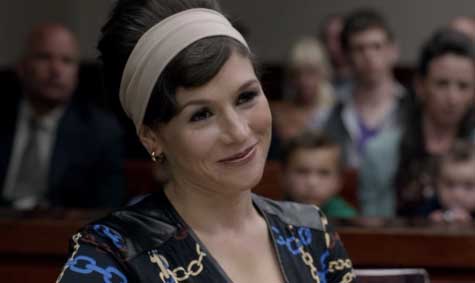
Now here is a damn fine hour of television. Episode Four of Orange Is the New Black is pretty much a perfect distillation of what makes this show great. It features multiple storylines—some played for laughs, some played for pathos, and one that is downright disturbing—and all of them overlap or intersect in interesting ways. The episode was written by Sian Heder, with work by Lauren Morelli, Nick Jones and the show’s creator Jenji Kohan, and it was directed by Phil Abraham. After three strong episodes in which the show has been setting up the season, Orange Is the New Black achieves lift off with Episode 4.
The main storyline—the one that is the most powerful and unsettling—involves Lorna Morello (Yael Stone). Up to this point, Morello has been a lovable figure. Soft spoken, with a rare-for-prison attention to cosmetics, she’s naturally sweet and kind. She is, in a word, likable. As with pretty much every inmate on the show, however, we have to wonder: what is she in for? What did this gentle soul do to get herself put in prison?
I’m going to refrain from giving away Morello’s past in this post, even though I know that the information is readily available elsewhere in the cultural ether. The way the series has rolled out Morello’s story is so smart, and so deft, that I’ll feel guilty just blabbing it. What I want to point out is how—if you go back over the previous sixteen episodes—there are little breadcrumbs every so often that will lead you to Morello’s secret. There is a whole other meaning to those tearful phone calls to her fiancée. Morello’s story is the highlight of the season so far; it’s both a nail-biting piece of suspense and a beautifully revealing piece of drama. All of this is made possible, of course, because of the performance of the incredible Yael Stone—who deepens and complicates the character we’ve come to love, showing us a darker side than we could have imaged, without ever letting us lose sight of the human need that drives her. (Someone give Stone an award already. In fact, give her all the awards.)
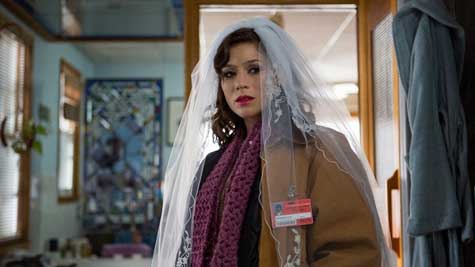
The episode is bookended with Morello. We see her waking for the day, attending to her makeshift beauty regimen, preparing for her job as the driver of the prison van. By the end of the episode, as the girls gather in the hall to watch The Secret of My Success, we’ve traveled a long way with Morello. The closing image of her watching the sunny rom-com through tears is powerful because, by this point, our entire conception of the character has changed. This is storytelling of the highest caliber—surprising, moving, haunting.
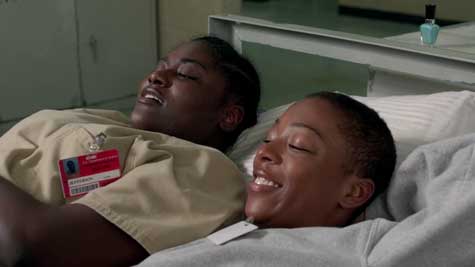
The other big storyline of this episode involves the relationship between Taystee (Danielle Brooks) and Poussey (Samira Washington). Lesbianism has long been a subtext of the Women In Prison genre, but Orange Is The New Black is exceptional for both its humor and its honesty. The fluid gender dynamics of prison life get a full treatment here. Poussey is gay, and she’s clearly in love with Taystee. While Taystee loves Poussey, she’s not gay. The two could give each other comfort and warmth, but Taystee has her reputation to consider—especially once Vee (Lorraine Toussaint) makes it clear that she disapproves of their relationship. (Although we suspect that Vee’s disapproval has an end goal in mind. She wants Poussey to work for her. Is she playing the girls against each other to maneuver both of them into positions that benefit her?) Next to Morello, Poussey might be the nicest character on the show. Watching Taystee reject her in order to impress Vee is heartbreaking.
The dramatic Taystee/Pouseey relationship is mirrored by the comic triangle of Big Boo (Lea DeLaria), Nichols (Natasha Lyonne) and the new inmate Brook Soso (Kimiko Glenn). Between them, Boo and Nichols have romantically conquered half the prison, and they both have their sights set on the new girl. As each of them works her particular brand of magic (Boo coming on strong, Nichols trying the shoulder-to-cry-on approach) the question of Soso’s sexual orientation never really comes up.
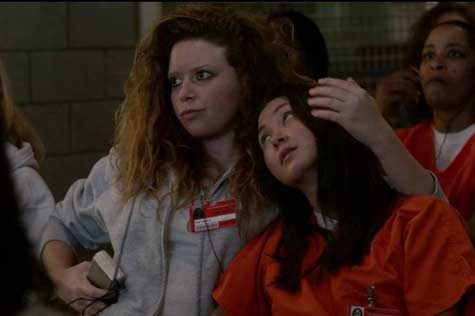
The Taystee/Pouseey story and the Big Boo/Nichols/Soso story both tie into the episode’s overarching theme of self-exploration. When Poussey creates a device that will enable her to urinate standing up (“I could call it the She Wee!”), the girls all have questions about their anatomy. In a nice turn of events, it falls to Sophia to explain the finer points of the female body to the girls as a male guard stands in the back of the room with an astonished look on his face. Sophia should teach sex education to the world.
In true Orange Is the New Black fashion, there’s a lot more going on: Red and Piper become roommates and then make tentative steps toward friendship, Red gets a job running the defunct greenhouse (which grows out of some yet-to-be-revealed master plan), and Vee is stoking a racial conflict with the Latinas. As with everything Vee does, we’re pretty sure that there are schemes within schemes at play here.
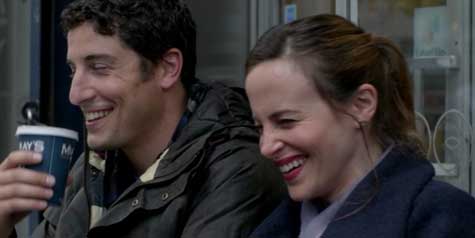
One final closing thought: the Larry/Polly relationship is now the storyline all fans of this show love to hate. Jason Biggs, you’re officially the Quinn Perkins of Orange Is the New Black.
Jake Hinkson, The Night Editor, is the author of The Posthumous Man and Saint Homicide.
Read all posts by Jake Hinkson for Criminal Element.
